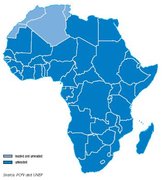Atmospheric resources and development challenges in Africa
Contents
- 1 Mitigating causes and impacts of climate variability and air pollution
- 2 Early warning systems
- 3 Investing in drug availability
- 4 Building buffers
- 5 Investing in food production and storage systems
- 6 Extreme weather funds
- 7 Conserving wetlands and woodlands
- 8 Energy efficiency
- 9 Fuel switch
- 10 Local vehicle manufacture and traffic management
- 11 Further Reading
Mitigating causes and impacts of climate variability and air pollution
Policy interventions are necessary, in the short term, to reduce the effect and impact of extreme climate changes on lives, livelihoods and infrastructure; in the medium term, to reduce emissions and pollutant concentration in the atmosphere, whilst at the same time limiting the release of more emissions and pollutants into the air; and in the long term, to adapt to climate variability and change.
 Energy production from coal is one of the largest contributors to CO2 emissions. Power generation, South Africa. (Source: A. Mohamed)
Energy production from coal is one of the largest contributors to CO2 emissions. Power generation, South Africa. (Source: A. Mohamed) Globally, mitigation measures have primarily targeted reducing pollutants and ozone-depleting substances as well as stabilizing greenhouse gas (GHG) concentrations in the atmosphere through increased sinks and reduced emissions. Programme Area 5 of the New Partnership for Africa’s Development Environment Action Plan (NEPAD-EAP) specifically focuses on combating climate change in Africa. These global and regional responses may help reduce the frequency and severity of floods, drought and heat waves; the loss of snowcaps; and sea-level rise. This will have positive implications for livelihoods and human well-being. Additionally, mitigating climate change and air pollution (Air pollution emissions) interventions offer business opportunities that contribute to job creation, poverty reduction and other NEPAD objectives.
Early warning systems
Given the failure to reduce emissions significantly, extreme weather events are predicted to occur with increasing frequency and severity. Investing in capacity for early warning systems will reduce both direct and secondary impacts of such events. Forewarned is forearmed: people will be able to accumulate food reserves, reinforce shelter or move to safer ground. Information and capacity-building lie at the heart of developing effective response systems. The ability to respond effectively is also affected by available resources, such as transport, to leave a threatened area. Poverty may prevent many communities from taking proactive measures, even if they are forewarned. Public support and international partnerships are critical for effective response systems.
Africa should invest in research to be able to develop, construct, deploy and use early warning systems. Community-based traditional warning systems should be researched and, where viable, developed and deployed. Early warning requires regionally and internationally linked systems, where spatial and temporal data from numerous observation points are brought together for analysis. International cooperation is therefore essential in developing effective early warning systems. Investing in the production of early warning systems will contribute to wealth creation and achievement of NEPAD objectives.
Investing in drug availability
In the short term, diseases and epidemics linked to climate change (Causes of climate change) and climate variability will continue to occur. African governments should encourage the private sector to invest in the pharmaceutical sector and manufacture drugs to combat malaria, typhoid, diarrhoea and other diseases. Manufacture of other disease-preventing products, like mosquito nets and repellents, will help reduce the incidence of diseases. These measures are essential to meeting regional and global development targets.
Building buffers
Floods, when left uncontrolled, cause severe damage to livelihoods and result in the loss of life. Building buffers along coastlines and rivers prone to flooding will help reduce damage. Investing in capacity to design and construct such buffers creates jobs which contribute to reducing poverty. This is particularly effective when the affected communities are actively involved in the process. Building buffers will also boost the construction sector. Preventing damage to infrastructure will directly contribute to a NEPAD objective of ensuring good infrastructure in Africa.
Investing in food production and storage systems
Given agricultural production systems and the high levels of subsistence production, rural people are particularly vulnerable to extreme weather events.
In the face of climate change (Causes of climate change) and possibly increasing aridity, developing crops that will grow with minimal rain is a good investment. Agricultural research institutes in a number of African countries, including Kenya Agricultural Research Institute (KARI) in Kenya, are already working on developing drought-resilient food and cash crops. The success of this research could contribute to poverty alleviation in some of the most disadvantaged and marginalized communities. Women in arid and semi-arid land (ASAL) areas will particularly benefit from drought-resilient crops. Men will be most likely to continue with livestock husbandry.
Investing in food reserves and storage improves food security. Besides storage, there are benefits in investing in post-harvest food processing and distribution networks. A large network of retailers can serve as a food reserve. South Africa has an elaborate post-harvest food processing and packaging industry that should serve as an example to other countries.
Extreme weather funds
Extreme weather events create a series of problems that can lead to severe loss of production and the collapse of an entire economy. For example, Kenya experienced a severe drought in 1999-2001, which caused a shortage of water in a dam, leading to closure of power plants and subsequent blackouts and power rationing. This has forced many industries to reduce production or even to shut down. The Kenya economy lost so much that the government was forced to invest in emergency generators at a cost of US$120 million. Raising such large amounts of money at short notice can prove to be a major challenge to most African governments, and such unplanned investments divert funds from other sectors and interrupt planned programs. Establishing a financial mechanism to ensure an extreme weather reserve fund will reduce the impact on the economy and reduce loss of lives and property.
Conserving wetlands and woodlands
Draining wetlands and destroying woodlands is a major cause of environmental degradation. Investing in the conservation of these zones will reduce the impacts of climate variability. In addition, woodlands and wetlands provide opportunities for ecotourism thereby contributing directly to job creation, poverty reduction and other NEPAD objectives.
Energy efficiency
The efficient use of energy is an opportunity for reducing greenhouse gas (GHG) emissions which also contributes directly to achieving social and economic development. Efficient burning of fuels in industry, transport and household sectors is a win-win process. Saving energy saves fuel and money. Investing in energy-efficient technologies will contribute to an improvement of a firm’s bottom line. For example, Kenya is currently implementing a GEF- and UNDP-funded, energy-efficient project for small and medium enterprises (SMEs); this US$5 million project has contributed to awareness creation and capacity-building for energy-efficient adoption in SMEs.
Investing in cleaner production saves materials and energy and also reduces GHG emissions. Africa should continue with the ongoing establishment of national cleaner production centers. These centers will assist industries switch to “cleaner” production and products. The Clean Development Mechanism (CDM) adopted under the Kyoto Protocol of the United Nations Framework Convention on Climate Change (UNFCCC) is a project-based tool designed to make it easier for industrialized countries to reduce greenhouse gas (GHG) emissions. It relies predominantly on market-based tools. Through carbon trading, developing countries can use this mechanism to support sustainable development initiatives. Africa’s participation in carbon trading is still relatively small.
Fuel switch
Switching from fossil fuels to renewable energy resources contributes to GHG emission reductions. Moving away from traditional to modern energy forms entails changing fuels from solid to liquid, liquid to gas, and gas to electricity as end-use energy forms. African rural and urban poor will particularly benefit from fuel switch.
Phasing out leaded fuels will reduce pollution and lead-induced sicknesses. In the Dakar Declaration of 2001, sub-Saharan Africa (SSA) agreed to phase out leaded gasoline. The Partnership for Clean Fuels and Vehicles (PCFV), formed at World Summit on Sustainable Development (WSSD) in 2002, was developed to support this phasing out. At that time, only one country in SSA, Sudan, was completely lead-free. However, as of January 2006, with South Africa going unleaded, all of SSA has now switched.
There are several projects across Africa implementing fuel switch programs. The Servant Flood of Light Development Foundation and Community Uplift Ministries of the USA are promoting a fuel switch project in Kenya. The project involves replacing firewood with gas for cooking, and kerosene with battery-powered electric lamps for lighting. The project relies on a gas-powered electricity generator for charging batteries at community levels. Two projects, recently launched in Kitale and Vihiga districts, are so far giving the expected results. However, it is still too early to make concrete conclusions on the future of these projects.
Local vehicle manufacture and traffic management
The manufacture of motor vehicles in Africa is an opportunity for job creation and poverty reduction, which could contribute to GHG emission reductions by making new vehicles more easily available to consumers. Many countries in sub-Saharan Africa (SSA) rely on imported used vehicles. Not only is this practice paramount to exporting jobs, but it contributes to pollution problems. By building capacity for new vehicle production, Africa will create jobs, reduce poverty and help conserve the environment. Investing in efficient combustion and engine tuning will provide new business opportunities whilst reducing GHG emissions.
The development of efficient public transport systems in developing countries can provide badly needed mobility, reduce the rate of growth of private vehicle use, and offer an opportunity to reduce pollution (Air pollution emissions).
Further Reading
- UNEP, 2006. Africa Environment Outlook 2
|
|
| Disclaimer: This article is taken wholly from, or contains information that was originally published by, the United Nations Environment Programme. Topic editors and authors for the Encyclopedia of Earth may have edited its content or added new information. The use of information from the United Nations Environment Programme should not be construed as support for or endorsement by that organization for any new information added by EoE personnel, or for any editing of the original content. |
